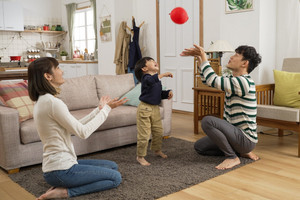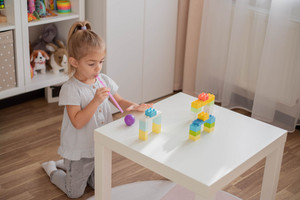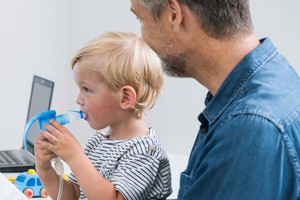Children with chronic lung diseases often have to deal with a build-up of mucus in their bronchial tubes. The mucus has to be drawn out of the lungs to prevent infections and other damage to the lung tissue.
Besides inhalation, breathing techniques and mobilisation exercises, active games help loosen the mucus. Here we show you three simple ideas.
The aim of all games that we show you here is to either boost the circulation in the lungs or to breathe out against a resistance and thus open the bronchial tubes wide. Both have the positive effect that different areas of the lungs are ventilated and so the secretions in those areas can be released.

Be it kid dancing, belly dancing or freestyle – every dance means moving the upper body. Dancing automatically stretches and twists the chest, and in doing so mobilises both the chest and the intercostal spaces, the spaces between the ribs. This benefits breathing and mobilises mucus.
Age recommendation: from about 18 months
You can also use this idea for babies. Pick up your baby and dance around and rock him or her.

Children love to play with balloons, on their own or with someone else. Take advantage of this. The balloon should be kept in the air for as long as possible and passed so that it does not touch the floor. This gentle game is good for the lungs because the stretches and twists mobilise the chest.
Children also often jump or sprint when they play this game, which in turn boosts circulation and so stimulates blood flow to the lungs. The vibrations caused by jumping and running also loosen secretions. The change in position from stretching for the balloon or bending also help mobilise the mucus.
Age recommendation: from about 2 years

Blowing games where children breathe out against resistance hold the bronchial tubes wide open and so help loosen the mucus lodged in them. Party blowers that unfurl as you blow or party horns work well for these games. Children can also blow through a straw to make bubbles in a glass of water or blow away paper balls. Breathing out against a resistant makes the secretions easier to dislodge and discharge them without the urge to cough.
Age recommendation: for children aged 2 years and above
Even though mucus is released by coughing, your child should never cough too violently or too long. This can damage the lungs. If your child has as coughing fit during play, follow the tips and techniques to combat the urge to cough and fits of coughing. Children who are at least 4 years old can learn the techniques to supress a cough.

Ideally, you should play these games with your child after nebuliser therapy, when the mucus has already liquified by inhaling hypertonic saline solution, for example. You can establish these game session as a special treat – a reward for a smooth inhalation therapy.
So, for instance, you can play the balloon game with your child whenever they finish their inhalation, or the whole family can practice a family dance together. And while you are at it, you will also have lots of fun together.
Or you can let your child blow bubbles into their favourite drink and then finish it – even if that happens to be 100% fruit juice, lemonade or hot chocolate. You can alternate these games so that your child does not have a unhealthy sugary drink on the menu every day.
Children with chronic lung disease often feel that having to do their inhalation and breathing therapy religiously every day is a heavy burden. It is not unusual for the therapy to create conflict and it often develops into a point of friction, which also hurts the parents.
This is why we have compiled further advice on inhalation which can help children and their parents get through the day-to-day use of inhalation therapy:
This article was written in cooperation with the experienced physiotherapist and respiratory therapist Rita Kieselmann, who has been working in this field since 1974. Her focus is on the treatment of children and adults with chronic respiratory diseases.
Rita Kieselmann is the founder of the Physiotherapy working group in the Mukoviszidose e. V. (Cystic Fibrosis Association in Germany). She has also developed self-help techniques for clearing mucus such as modified autogenic drainage and others.
Note: The information in this blog post is not a treatment recommendation. The needs of patients vary greatly from person to person. The treatment approaches presented should be viewed only as examples. PARI recommends that patients always consult with their physician or physiotherapist first.
An article written by the PARI BLOG editorial team.
© 2025 PARI GmbH Spezialisten für effektive Inhalation